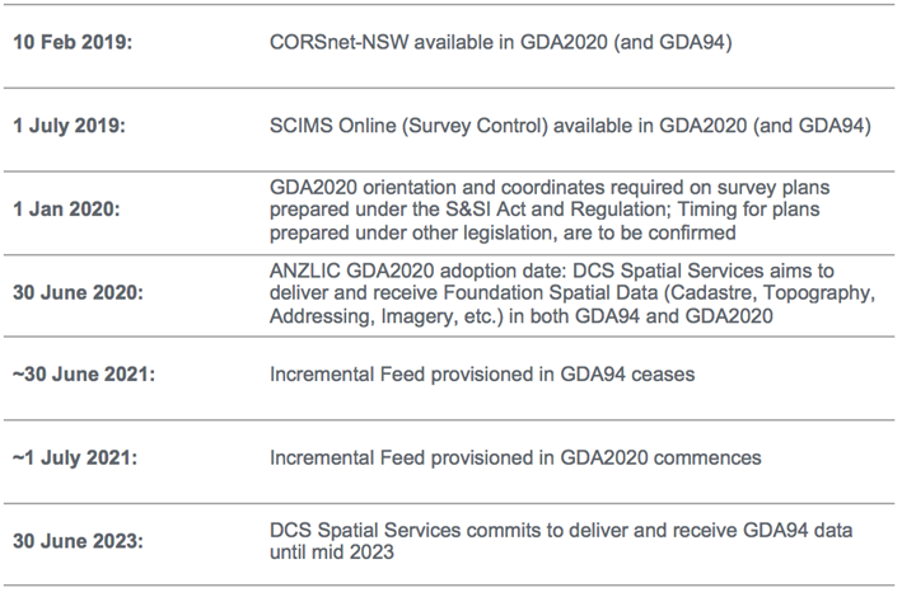Incremental Feed and GDA2020
May 2020
Please note that the following information is for existing Incremental Feed Clients only. Information regarding the availability of GDA2020 data from DCS Spatial Services will be made available in mid-late June 2020. Please revisit our website or LinkedIN in late June for that notice.
As a recipient of DCS Spatial Services data delivered through our Incremental Feed please note the following information. The baseline supply and datum underpinning the current service is the Geocentric Datum of Australia 1994 (GDA94). The Incremental Feed supply is scheduled to switch to the new Geocentric Datum of Australia 2020 (GDA2020) in approximately one year, at or around 1 July 2021.
From 1 January 2020, GDA2020 was adopted as the datum for NSW. This change responds to amendments to the Surveying and Spatial Information Act 2002 (S&SI Act) and Regulation 2017 which commenced on that date. GDA2020 is now the prescribed datum for surveys carried out on behalf of the Surveyor-General or on behalf of other public authorities and is recommended for all other spatial information.
Data custodians should be aware that the ability to receive, consume and communicate a mixture of GDA94 and GDA2020 spatial information will become increasingly important, following these changes to legislation.
DCS Spatial Services is working to supply key datasets and services in both GDA94 and GDA2020.
Background
Australia sits on one of the fastest moving tectonic plates on earth, travelling almost seven centimetres north-east each year. To remain compatible with Global Navigation Satellite Systems (GNSS) such as GPS and to support high-accuracy positioning capabilities and the associated economic benefits, coordinates across Australia are being updated to account for this movement.
These critical upgrades to the Australian Geospatial Reference System (AGRS) are being made by the Intergovernmental Committee on Surveying and Mapping (ICSM). DCS Spatial Services is adopting GDA2020 as the first step in the process of datum modernisation.
Geocentric Datum of Australia 2020 (GDA2020)
- GDA2020 is a static datum – just like GDA94
- A ‘static’ datum means that the positions of features (e.g. roads, buildings and property boundaries), do not change over time despite ongoing changes in the Earth’s surface
- GDA2020 spatial data is be more closely aligned to modern GNSS (e.g. GPS), allowing users to more easily benefit from modern, high-accuracy positioning technologies
- Australia has moved up to 1.8 metres north-east since GDA94 was defined in 1994
- In NSW, the difference in GDA94 and GDA2020 coordinates will range from ~1.3 to ~1.8 metres depending on location as well as historical regional definitions of GDA94
- Users can transform between GDA94 and GDA2020 using nationally adopted transformation parameters or grids
- Where required, the ongoing 7cm / year tectonic plate motion can be corrected to bring future high-accuracy spatial information back in line with GDA2020
Incremental Feed migration to GDA2020
The Incremental Feed service can only deliver spatial data in one datum:
- GDA94 will continue as the datum utilised in the baseline supply supporting existing Incremental Feed services until approximately June 30, 2021
- GDA2020 will be utilised for the baseline supply for Incremental Feed from approximately July 1, 2021
Incremental Feed consumers that need to migrate to GDA2020 before July 2021 can do so by:
- Developing their own client-side transformation from GDA94 to GDA2020, or
- Independently sourcing brokers that can transform the data to GDA2020 on their behalf, or
- Migrating to alternative services being developed by DCS Spatial Services which support GDA2020. More information on these services will be available in July 2020.
Incremental Feed and GDA 2020 Timeline

DCS Spatial Services will continue to provide existing users with periodic updates about any changes to the Incremental Feed service. Users should understand that there are no imminent changes to the Incremental Feed service at this point in time.
Further information
For more information, please contact us via our Customer Hub: www.spatial.nsw.gov.au/contact_us
